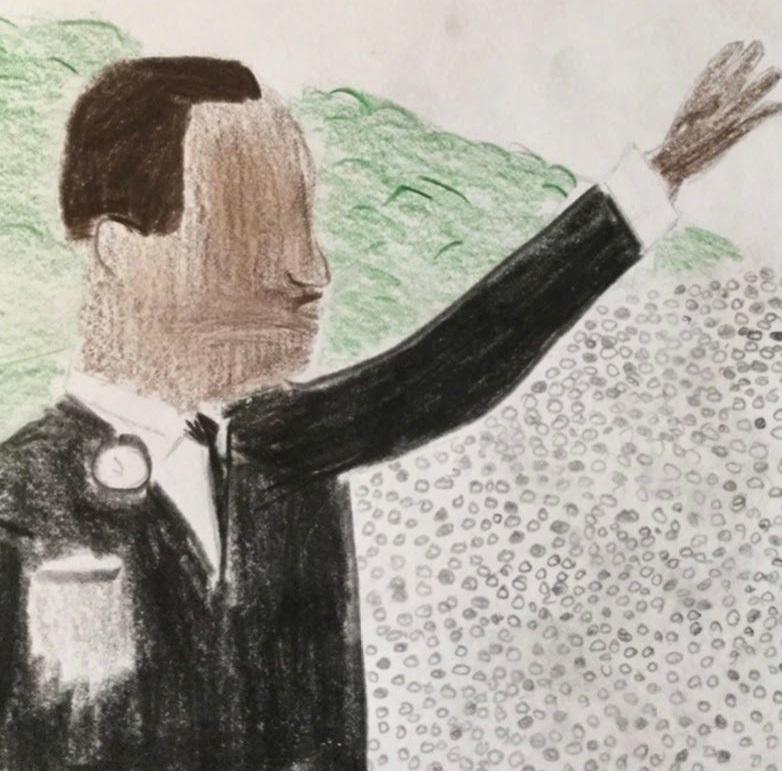At the Waldorf School, teachers incorporate current and historical stories and lessons about peoples and cultures around the world, Maryland and the other regions of the United States throughout the year. Children’s lessons will vary based on age, grade, and the class configuration. This last month teachers created meaningful ways to highlight Black History Month. Our Diversity, Equity, and Inclusion work has inspired expansion of our programmatic offerings. Being able to bring stories to children in way that meets where they are developmentally at their age is a fundamental practice in Waldorf education.
As the Rainbow Kindergarten students settled into their story circle in late February, Ms. Lawrence told a story about Rosa Parks. She introduced Rosa Parks by explaining how brave she must have been. As soon as the children heard they’d be hearing a story about bravery, they were hooked. Ms. Lawrence told the story in an age-appropriate way through the imagery of storytelling. She painted a picture of kindness , bravery and empathy.
“People are people no matter how different we look,” she told her class. “In fact, isn't it amazing how different we all look? Look around at each other... We all have different hair, skin, clothes and families. We all eat different foods. We can all learn so much from each other. And most importantly, we can all be friends here in the Rainbow Kindergarten."
Finding Wonder and Joy in Art
Ms. McGlory, in the Cherry Tree class, explored the book “Parker Looks Up” with her students. “I chose this book because it tells the story of Parker Curry’s visit to the American Portrait Gallery and the wonder she experiences when seeing Michelle Obama’s portrait.”
Students in art and handwork classes also found inspiration through Black artists creating fine art. Ms. Mulvihill explored the work of Baltimore-based artist Stephen Townes with the eighth grade class as they embarked on a self-portrait tapestry project. In preparation for this work, Ms. Mulvihill had eighth grade examine and discuss the work of local artist Stephen Towns. Towns is a painter and fiber artist whose work explores how American history influences contemporary society. Some of his more recognizable work includes quilts depicting moments from Harriet Tubman's journey and his piece "Birth of a Nation" which was displayed at the Baltimore Museum of Art in 2018.
Learning by Moving
Ms. Saunders highlighted Black History for eurythmy classes through poetry and dance. Classes explored work by James Weldon Johnson as well as Langston Hughes. The seventh grade’s work with Ms. Saunders overlapped with their language arts studies as they performed haiku eurythmy through studying various Harlem Renaissance poets – authors they were also looking at during main lesson.
Reinforcing main lessons in eurythmy gives children another way to understand literature, language and art by letting them experience written words through movement. Fourth graders spent part of February learning African dances in eurythmy. Throughout the month, in Main Lesson they began their day dancing and hearing music by Black artists.
In music class, Ms. Weisheit began celebrating Black contributions in music and Black History in honor of for Rev. Dr. Martin Luther King, Jr.’s birthday when students began singing “Lift Every Voice and Sing” and “Everybody Ought to Know.”
“Our celebration carried on right through Black History Month with the studies of songs, musical styles and performers including Duke Ellington, Ella Fitzgerald and Sonny Greer” she said.
Biographical Stories in Middle School
By the time children reach middle school, they’re able to digest more complex issues compared to in early childhood. So middle school teachers also took the time to thoughtfully incorporate age-appropriate Black History Month events into their classrooms.
In sixth grade Ms. Miller’s class explored African American heroes through language arts. Each student researched and gave an oral presentation on a hero. Then the students then voted as a class based on those presentations on who they’d like to take a deeper look at together.
“Harriet Tubman was first place and Frederick Douglass was next,” said. Ms. Miller. “I presented a biography and then the students wrote letters of admiration to Ms. Tubman. The week wrapped up with a grammar review on common nouns and proper nouns featuring Harriet Tubman’s story.”
The students also did some work with metaphors based on historical quotes and created analysis essays in addition to illustrations.
Seventh graders took a deep dive into language arts while learning about Black History throughout February. In addition to hearing poems from the Harlem Renaissance period, students also read and discussed excerpts from Maya Angelou’s “I Know Why the Caged Bird Sings”.
Ms. Jones also created a beautiful intro for the middle school students highlighting why it's important for all of us to celebrate black history this month and all year long.
“The study of Black history forces us to examine the wonderful promise the founders of our country made to preserve human freedom and dignity. By exposing the limitations of that promise, we should be all the more committed to upholding it more fully.”

